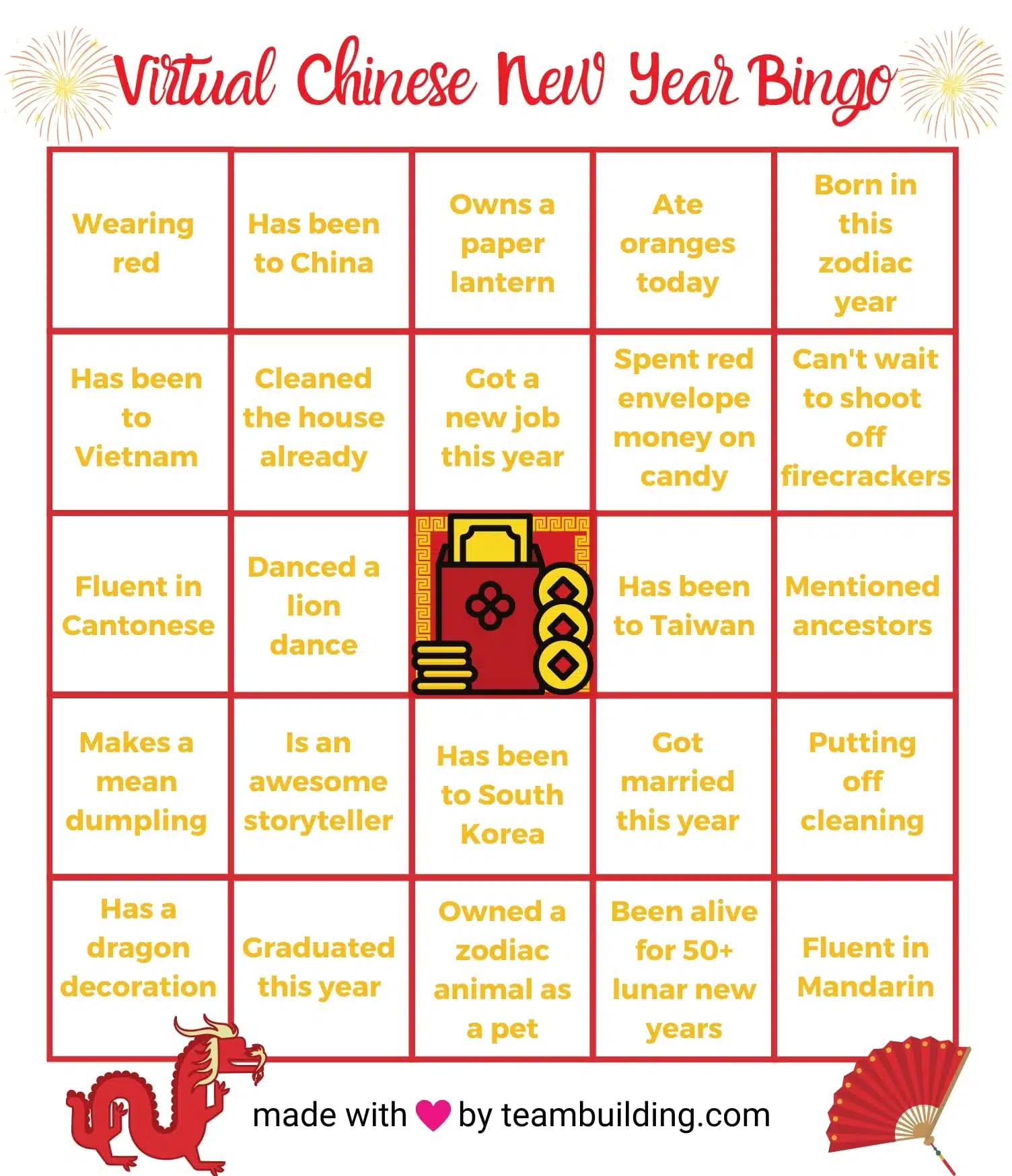Xīn nián kuài lè! You found our guide to virtual Chinese New Year.
Chinese New Year is the most important holiday for people of Chinese descent. Many places that have significant Chinese populations, such as China, Taiwan, South Korea, Thailand, Vietnam, Singapore, Indonesia, and the Philippines, celebrate a version of this holiday on the first day of the first month in the lunar calendar. Since the purpose of this holiday is to honor ancestors and often involves traveling, businesses in these countries are often closed for up to a week. This holiday is also known as the Lunar New Year or Spring Festival.
In 2022, the first day of the Chinese New Year will be on Tuesday, February 1, and it begins the Year of the Tiger.
This day is an example of a virtual team celebration and a virtual holiday party.
This guide includes:
- Chinese New Year online activities
- Virtual Chinese New Year games for Zoom
- Virtual CNY celebration ideas
- Greetings you can use for the holiday
Let’s get into it!
List of Virtual Chinese New Year ideas
These pointers will help make your event pop, while still remaining respectful of tradition.
1. Unscramble Chinese New Year Word Jumbles
Whether you celebrate with children or adults, word jumbles are a fun, brain-bending way to get into the spirit. These puzzles contain mixed-up versions of holiday words which solvers must decode. For an even more exciting activity, make the jumbles into a race, and award the first participant to list all words correctly with a prize.
We made a template for you to use.

And here is the answer key:

2. Play Virtual New Years Bingo
Bingo is a great game to play for any occasion. In honor of Lunar New Year, we created a holiday-themed Virtual Chinese New Years Bingo template for you to use at your online gathering.

To play, send the card to participants, then give players time to mingle and chat. Players write the name of party companions that fit descriptions in the name on the squares. The first player to get five consecutive squares, without repeating names, wins.
Here are more games to play on video meetings.
Get our free team building toolbox
- icebreaker games
- bingo cards
- DIY guides
 by teams at FedEx, Amazon, Deloitte and 73,930+ others
by teams at FedEx, Amazon, Deloitte and 73,930+ others

3. Set a red dress code
Red is a lucky color in Chinese culture, which is why traditionally people wear this color during Chinese New Year and weddings. Since the holiday also celebrates fresh beginnings, new red clothes are often the ideal outfit choice. To bring this element to your virtual party, institute a dress code, where your team comes in red ensembles.
4. Involve your team’s families
Chinese New Year is a holiday that families celebrate together. To integrate this aspect, open up your virtual gathering to your team’s family. Since everyone is celebrating from home, it should be easier to get family members to join the fun.
5. Play Chinese New Year songs
Like Christmas, Chinese New Year also has a host of songs associated with it. Spotify created a playlist for the holiday, but many of the user-compiled playlists are good, too. During the festivities, play songs in the background to help set the mood and prevent the event from becoming too dry or boring.
6. Hold a paper cutting workshop
A popular craft related to Chinese New Year is paper cutting. Using red paper, you can create a 3D version of the character for “spring”. The craft is pretty simple to do, and does not require many materials to complete. After cutting out your “spring,” you also have the option to hang it rightside up or upside down. Because “upside down” in Mandarin sounds like the word for “arrived,” by hanging “spring” upside down, you symbolize that spring has arrived.
You may want to do an online art class as well.
7. Watch a lion dance performance
While watching a lion dance performance in person may be out of the question, you can watch recorded performances on YouTube together with your team. In Chinese culture, lions are auspicious animals, which is why stone carvings of lions are often placed outside of temples. Watching the acrobatic performance together can be a cool moment of cultural exchange.
8. Set up a talent show
Previously, I mentioned the elaborate Chinese New Year television specials broadcast in China and Taiwan. The content of these specials consists of popular celebrities displaying talents like dance, singing, or comedy sketches. Your team can take inspiration from these specials by holding a talent show. Not only will you learn more about your teammates’ special skills, but talent shows are also great sources of entertainment.
Here are more tips on how to do a virtual talent show.
9. Book a virtual tea tasting
Tea plays an important role in Asian Cultures. This Lunar New Year, plan a team building virtual tea tasting experience to teach your guest about the history, growing practices, and preparation rituals of the drink. There are many providers that offer sampler packs and classes geared towards Asian teas, and we recommend booking one of these experiences. Typically, when you order the class, the hosts will send attendees a Zoom link and will mail a tasting kit, and then will join the call to lead the class and answer questions.
Check out this list of online tea tasting class providers.
10. Hold a remote reunion dinner
One of the most beloved traditions of Chinese New Year is tuan nien fan, also known as the reunion dinner. On Chinese New Years Eve, folks gather to share a meal with the entire family. It is considered one of the most important meals of the year in many Asian countries, if not the most important.
If you are planning a meal for coworkers or friends, then you may want to host a lunch instead or hold your dinner on another day, since celebrants may want to celebrate officially with family. However, you can also invite family members to join the party and have one big remote meal together.
To host the Zoom meal, have each attendee order or prepare food beforehand. Common Lunar New Year dishes include fish, dumplings, spring rolls, and noodles. Then, get together and eat onscreen while enjoying each other’s company.
You can send participants a gift card to cover the cost of the meal, or offer to reimburse the expense.
Here is a guide to doing meals remotely.
11. Play online mahjong
Mahjong is a game that has been played on the Asian continent for hundreds of years. In Hong Kong, many celebrants count down to the new year by playing the game. You and your fellow celebrants can add a competitive element to the festivities by playing a few rounds of Mahjong together online.
Here is a version of Mahjong you can play online with friends, and here is a Chinese New Year version of the game.
12. Display festive Zoom backgrounds
One of the easiest ways to celebrate the occasion is to display on-theme Zoom backgrounds for your virtual party and during remote meetings throughout the month. Participants can change their background display to red designs, pictures of parades, skylines of Asian cities, and images of the animal of the year. You can hold a contest to choose which attendee has the best background. You can also have an artsy attendee create a few special Chinese New Year-themed backgrounds on Canva, and send these graphics along with the invitations so that guests can use the backgrounds on the call.
For more inspiration, here is a list of ways to make Zoom meetings fun.
13. Set up a digital photo booth
Digital photo booths are fun ways for remote folks to get into the holiday spirit and commemorate the occasion. These apps use visitor’s webcams to take photos with special frames, backgrounds, and effects. You can customize the theme to be Chinese New Year specific, for example by featuring fireworks, dragons, the year’s Zodiac animal, and new year’s wishes.
You can partner with an event or photography company to set up the booth, or DIY with a YouTube video.
14. Craft paper lanterns
Lunar New Year typically ends with a paper lantern festival. To ready your group for the festivities, you can hold a Chinese lantern-making session online. First, send kits or lists of supplies to your crew. Then, meet up on a Zoom call and either follow a video tutorial or make the project alongside the guide. Be sure to leave time at the end to show off the creations. You can even create an online photo gallery where attendees can upload photos of the finished products.
15. Launch an online costume contest
You can hold an online costume contest to find out which of your guests can best channel the Zodiac animal. First, create an online photo gallery in a private social media group, on Slack, in a shared Google Drive, or in a cloud-based smartphone album like iCloud. Then, invite participants to the album and encourage them to submit pictures of themselves dressed as the Chinese Zodiac animal of the new year. Once the entry deadline has passed, have guests cast votes for their favorite photos by liking, commenting, or reacting with emojis. During your Zoom call, announce the winner, and send the honoree a special prize.
Here is a guide to doing costume contests online.
How to celebrate Chinese New Year online
It may seem far-fetched to celebrate Chinese New Year, a holiday where families often travel across the country to get together, over the internet. However, with the advent of technology, traditions change.
Here is how to celebrate a virtual Chinese New Year:
Step #1: Send virtual invitations
The first step in holding a virtual Chinese New Year is to send virtual invitations letting your team know the date, time, and location of the event. By giving team members this information, you provide them the opportunity to clear their schedules for the festivities.
You can create virtual Chinese New Year invitations at:
Feel free to include a dress code and basic rundown of activities. Since Chinese New Year is a cultural celebration, your coworkers may not be familiar with this holiday.
Step #2: Upload pictures of your clean house
Prior to the festivities, a culturally-sensitive way to get people hyped about the event is to ask colleagues to send a picture of a clean house to your team message board. This action is a reference to Chinese New Year being a time of new beginnings, where Chinese families have the tradition of cleaning their homes.
Step #3: Get online
If you are the host of virtual Chinese New Year, then log into the video conference service before everyone else does to check for technical difficulties. Once you have confirmed that your camera and mic are working, let the other participants enter from the waiting room. Consider using a festive Zoom background to help set the mood.
Step #4: Trade “red envelopes”
Traditionally, older members of the family usually give red envelopes to children, with adult children reciprocating to their parents and grandparents once they start earning money. Additionally, the amount of money included in red envelopes is usually an even number, with people avoiding the number four because the Mandarin pronunciation sounds a lot like “death.”
Unfortunately, it may be difficult to trade the iconic red envelopes when celebrating virtually. However, if you are a manager, then give a token of appreciation to your team by giving employees a small bonus.
Here are some more gift ideas for employees.
Step #5: Eat together
One of the main events of Chinese New Year is the food, since eating together with the whole extended family is such a pivotal part of the holiday. Since you are celebrating with your team while everyone is at home, invite colleagues to bring along their family members as you all eat dinner together.
According to Chinese culture, the food you eat during New Year has meanings attached to them, usually due to puns.
Some classic foods to include with Chinese New Year dinner are:
- Fish: “Fish” in Mandarin sounds like “surplus,” so by eating this food, you are wishing everyone to have a surplus of good things in the new year.
- Dumplings: Dumplings resemble yuanbao, which refers to the golden ingots that were used as ancient Chinese currency.
- Apples: “Apple” in Mandarin sounds like “peace.”
- Mandarin oranges: “Orange” in Mandarin sounds like “luck.”
- Niangao: Niangao is a pun for “a more prosperous year.”
Send this list of food items along to your team, so employees can prepare for dinner. When you share your meal, you and your team will benefit from the lucky associations that each food item has.
Here is a list of online cooking classes you can do with your team.
Step #6: Share stories of your family
Another essential component of Chinese New Year is honoring your ancestors. To incorporate this tradition into the festivities, encourage your team to share stories of their family during dinner. Sharing a bit of family history is an excellent way for team members to get to know each other better.
Step #7: Tell stories of the Nian beast
To help explain why the Chinese associate certain traditions with New Years, tell the story of the Nian beast. “Nian” is Mandarin for “year,” and the legend speaks of a beast that terrorized villages every year. One day, an old man arrived in town and drove away the beast by setting off firecrackers and wearing red, a color which hurt the Nian beast’s eyes. Because of this incident, people celebrating Chinese New Year wear red and set off firecrackers.
Telling this legend is a fun way to expose team members to Chinese culture and explain why certain traditions exist. The story of the Nian beast is especially suitable if colleagues bring their children to virtual Chinese New Year.
Step #8: Set off “firecrackers”
Setting off firecrackers is dangerous indoors. However, playing YouTube videos of people setting off firecrackers is a great way to vicariously and safely experience this tradition. Not to mention, now that your team is familiar with the Nian beast myth, they know the meaning behind this action.
Step #9: Wish everyone a happy new year
Another tradition associated with Chinese New Year is new year’s greetings. Many of these sayings have lucky or auspicious meanings to them, and usually work through puns. While celebrating with your team, teach your colleagues how to say a few simple phrases, so you can wish each other happy new year.
Here are the most common greetings:
- 新年快樂 (Xīnnián kuàilè): Happy New Year
- 恭喜發財 (Gōngxǐ fācái): Happiness and prosperity
- 吉祥如意 (Jíxiáng rúyì): Good fortune according to your wishes
- 年年有餘 (Niánnián yǒuyú): Surplus year-after-year
- 大吉大利 (Dàjí dàlì): Lots of luck and profits
- 恭喜發財,紅包拿來 (Gōngxǐ fācái, hóngbāo ná lái): Wishing you happiness and prosperity; give me a red envelope
Saying these greetings aloud to each other, even if pronounced badly, may be an amusing way for team members to let down their guard, while simultaneously learning some phrases in a new language.
Step #10: Stay up as long as you can
Finally, your team can continue celebrating even after the video call ends. In China or Taiwan, the festivities often continue until midnight, with large-scale television specials broadcast to keep family members entertained. These specials reflect a Chinese tradition which states that the longer the younger generations stay up, the longer the older generations will live. While staying up does not have a direct effect on your relatives’ longevity, you can still tell your team about this tradition, and see if colleagues decide to give it a try.
Conclusion
Chinese New Year is a very special time in many Asian countries. To do this holiday justice, incorporate as many cultural elements as you can, and educate yourself and your team members during the process. Just do not forget to have fun!
Next, check out our list of virtual New Years ideas and this one with games to play via Zoom.
We also have a list of the best team building ideas for Valentine’s Day.





